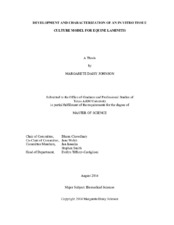| dc.description.abstract | Equine laminitis, a disease affecting the laminar tissue in the hoof, is a common and debilitating disease in horses with a significant impact on the equine industry. Currently nearly all laminitis studies are conducted in live horses, a process that is both expensive and limited in biological replicates. Thus the development of an in vitro model for the disease is an important step in advancing laminitis research. Recent evidence suggests that apolipoprotein A-IV (apoA-IV) may be involved in the chronic form of the disease but little is known about this protein in the horse, and its effects on the laminar tissue are unknown. The primary goal of this project was to produce a model for inducing inflammation in slices of laminar tissue in culture. We tested two inflammatory agents: interleukin 6 (IL-6) and lipopolysaccharide (LPS) and measured their effect on the expression of inflammatory cytokines and seven laminitis-associated genes found to be differentially expressed in horses with induced laminitis. The second goal of the project was to test the effects of apoA-IV on
laminar tissue inflammation in our model in the presence and absence of the two inflammatory agents, and to further characterize the protein in horses by determining its sequence and expression pattern in this animal.
The laminar tissue remained alive and contamination-free over the course of the experiment, showing the viability of our culture. IL-6 did not induce changes in gene expression consistent with those found in horses with laminitis. However, the addition of LPS led to changes in cytokine expression mimicking those seen in horses with induced laminitis and increased two of the seven laminitis-associated genes. The addition of apoA-IV had no effect on laminar tissue inflammation by itself or in the presence of IL-6 or LPS. We found the highest expression of APOA4 in the liver followed by the small intestine, a pattern unique in its high hepatic contribution. A better understanding of how apoA-IV is produced and functions in horses may shed light on its role in laminitis. In the future our tissue culture model could be used in testing agents suspected of causing laminar tissue inflammation and eventually in the development and testing of potential treatments for laminitis. | en |


